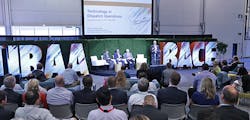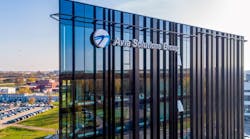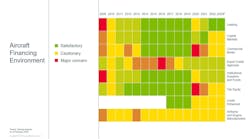We are living through a Fourth Industrial Revolution, presenter Greg Jones told attendees gathered in the Innovation Zone at NBAA-BACE.
“From steam through to electricity, electronics and IT, and onto the digital era, technology evolves rapidly,” said Jones, a global industry solutions manager for Microsoft. “Very quickly we’ve gone from the app world where everybody is really happy to be able to integrate with technology and information relevant for them, to a world where technology enables more personalized service presenting exactly what you want.”
The education session “Technology-Driven Trends in Business Aviation” examined how the industry stands to benefit from practical, working systems that may have seemed wildly futuristic just a few years ago. Even the relatively recent concept of virtual reality has evolved to become what Jones termed “mixed reality,” a true melding of the physical world with the virtual.
As one example, a HoloLens presents augmented images to a person within a physical environment. This allows entire flight departments to be designed while standing in an empty hangar, aircraft maintainers to see how complex assemblies fit together when working on an engine, or an air traffic controller to prioritize information they need most in specific situations and conditions.
Artificial intelligence (AI) also holds promise within aviation. Jones demonstrated a development program called “Seeing AI” that captures words, numbers, actions and even a person’s facial expression as seen through a smart camera, and a practical example of AI transcribing a McDonald’s drive-through order, adjusting to the customer’s vocal intonations and organizing the complicated order to a logical progression for it to be filled.
“Think about this in your industry,” continued Kristin Zaccheo, director of integration and alliances at Boeing’s Digital Aviation and Analytics Division. “Pilots fly all over the world communicating with ATC, but how often are they not able to understand an instruction? This is a way to utilize technology to account for confusing speech patterns or instructions, and convert them to a highly accurate digital record.”
Zaccheo also noted the transformative nature of apps already widely used across business aviation, such as Uber and Airbnb. “Industries are becoming transformed by technologies that allow them to become more personal,” she explained. “We don’t need a taxi anymore; we just need a car. Anybody can be a driver, with a single app connecting the person who serves with the customer who receives. Infrastructure we’re used to having doesn’t need to exist.
“I see a world where I no longer pay for a United flight, but rather I buy a seat and I get on the airplane and go,” Zaccheo added. “That could be disruptive, as it’s a structure that looks a lot like business aviation.”
Of course, such disruptive technologies can also invoke fears that such systems will ultimately assume too much control over certain scenarios, or even make complicated tasks “too easy.” Zaccheo downplayed such concerns.
“As you drive things down into a commodity, that allows you to focus on things that are true differentiators,” she noted. “Make the easy things easy, so you can figure out the harder problems you need to solve. I want pilots solving the hardest problems in the cockpit – not the stuff we can easily automate.”


